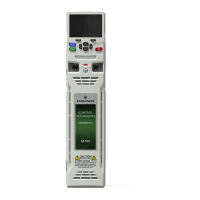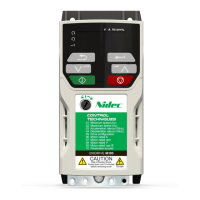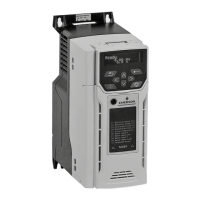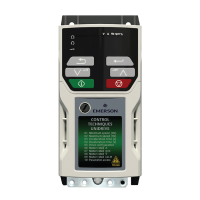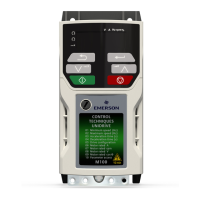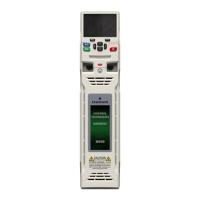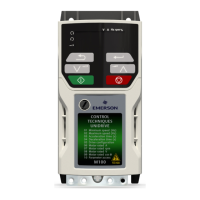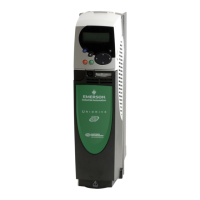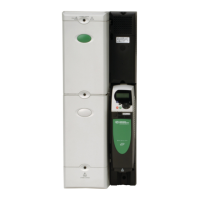Safety
information
Product
information
Mechanical
installation
Electrical
installation
Getting
started
Basic
parameters
Running
the motor
Optimization
NV Media Card
Operation
Onboard
PLC
Advanced
parameters
Technical
data
Diagnostics
UL listing
information
122 Unidrive M702 User Guide
Issue Number: 3
Pr 00.040 {05.012} Autotune
There are three autotune tests available in RFC-A mode, a stationary test, a rotating test and an inertia measurement test. A stationary autotune will
give moderate performance whereas a rotating autotune will give improved performance as it measures the actual values of the motor parameters
required by the drive. An inertia measurement test should be performed separately to a stationary or rotating autotune.
It is highly recommended that a rotating autotune is performed (Pr 00.040 set to 2).
• A stationary autotune can be used when the motor is loaded and it is not possible to remove the load from the motor shaft. The stationary
autotune measures the Stator Resistance (05.017) and Transient Inductance (05.024) of the motor. These are used to calculate the current loop
gains, and at the end of the test the values in Pr 04.013 and Pr 04.014 are updated. A stationary autotune does not measure the power factor of
the motor so the value on the motor nameplate must be entered into Pr 00.043. To perform a Stationary autotune, set Pr 00.040 to 1, and
provide the drive with both an enable signal (on
terminals 11 and 13) and a run signal (on terminal 7 or 8).
• A rotating autotune should only be used if the motor is unloaded. A rotating autotune first performs a stationary autotune, a rotating test is then
performed which the motor is accelerated with currently selected ramps up to a frequency of Rated Frequency (05.006) x 2/3, and the frequency
is maintained at the level for up to 40 s. During the rotating autotune the Stator Inductance (05.025), and the motor saturation breakpoints
(Pr 05.029, Pr 05.030, Pr 06.062 and Pr 05.063) are modified by the drive. The power factor is also modified for user information only, but is not
used after this point as the stator inductance is used in the vector control algorithm instead. To perform a Rotating autotune, set Pr 00.040 to 2,
and provide the drive with both an enable signal (on
terminals 11 and 13) and a run signal (on terminal 7 or 8).
• The inertia measurement test can measure the total inertia of the load and the motor. This is used to set the speed loop gains (see Speed loop
gains) and to provide torque feed-forwards when required during acceleration. During the inertia measurement test motor is accelerated with
the currently selected ramps up to a speed of Rated Speed (05.008) / 4, and this speed is maintained at this level for 60 seconds. The Motor
And Load Inertia (03.018) and load compensation parameters (Load Compensation Param 1 (04.031) to Load Compensation Param 4
(04.034)) are measured. If the required speed is not achieved on the final attempt the test is aborted and an Autotune trip is initiated. To perform
an Inertia measurement autotune, set Pr 00.040 to 3, and provide the drive with both an enable signal (on
terminals 11 and 13) and a run signal
(on terminal 7 or 8). Following the completion of an autotune test the drive will go into the inhibit state. The drive must be placed into a controlled
disable condition before the drive can be made to run at the required reference. The drive can be put in to a controlled disable condition by
removing the SAFE TORQUE OFF signal from
terminals 11 and 13, setting the Drive Enable (06.015) to OFF (0) or disabling the drive via the
control word (Pr 06.042 & Pr 06.043).
Pr 05.016 Motor Parameter Adaptive Control
The motor Rated Speed (00.045) in conjunction with the motor Rated Frequency (00.047) defines the full load slip of the motor. The slip is used in
the motor model for RFC-A control. The full load slip of the motor varies with rotor resistance which can vary significantly with motor temperature.
When Pr 05.016 is set to 1 or 2 the drive can automatically sense if the value of slip defined by Pr 00.047 and Pr 00.045 has been set incorrectly or
if it has varied with motor temperature. If the value is incorrect Pr 00.045 is automatically adjusted. Pr 00.045 is not saved at power-down, and so
when the drive is powered-down and up again it will return to the last saved value. If the new value is required at the next power-up it must be saved
by the user.
The adaptive control system is only enabled when the |Output Frequency (05.001)| is above Rated Frequency (05.006) / 8, and the |Percentage
Load (04.020)| is greater than 60 %. The adaptive control system is disabled again if the |Percentage Load (04.020)| falls below 50 %. For best
optimization results the correct values of Stator Resistance (05.017), Transient Inductance (05.024), Stator Inductance (05.025), Saturation
Breakpoint 1 (05.029), Saturation Breakpoint 2 (05.062), Saturation Breakpoint 3 (05.030) and Saturation Breakpoint 4 (05.063) should be used.
If Motor Parameter Adaptive Control (05.016) = 1 the gain of the adaptive control system is low and hence the rate at which it converges is slow. If
Motor Parameter Adaptive Control (05.016) = 2 the gain is increased by a factor of 16 and the convergence rate is increased.
Pr 00.038 {04.013} / Pr 00.039 {04.014} Current Loop Gains
The current loop gains proportional (Kp) and integral (Ki) gains control the response of the current loop to a change in current (torque) demand. The
default values give satisfactory operation with most motors. However, for optimal performance in dynamic applications it may be necessary to
change the gains to improve the performance. The Current Controller Kp Gain (04.013) is the most critical value in controlling the performance. The
values for the current loop gains can be calculated by performing a stationary or rotating autotune (see Autotune Pr 00.040, earlier in this table) the
drive measures the Stator Resistance (05.017) and Transient Inductance (05.024) of the motor and calculates the current loop gains.
This will give a step response with minimum overshoot after a step change of current reference. The proportional gain can be increased by a factor
of 1.5 giving a similar increase in bandwidth; however, this gives a step response with approximately 12.5 % overshoot. The equation for the integral
gain gives a conservative value. In some applications where it is necessary for the reference frame used by the drive to dynamically follow the flux
very closely (i.e. high speed Sensorless RFC-A induction motor applications) the integral gain may need to have a significantly higher value.
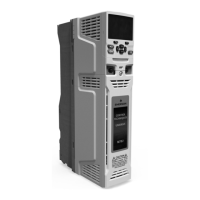
